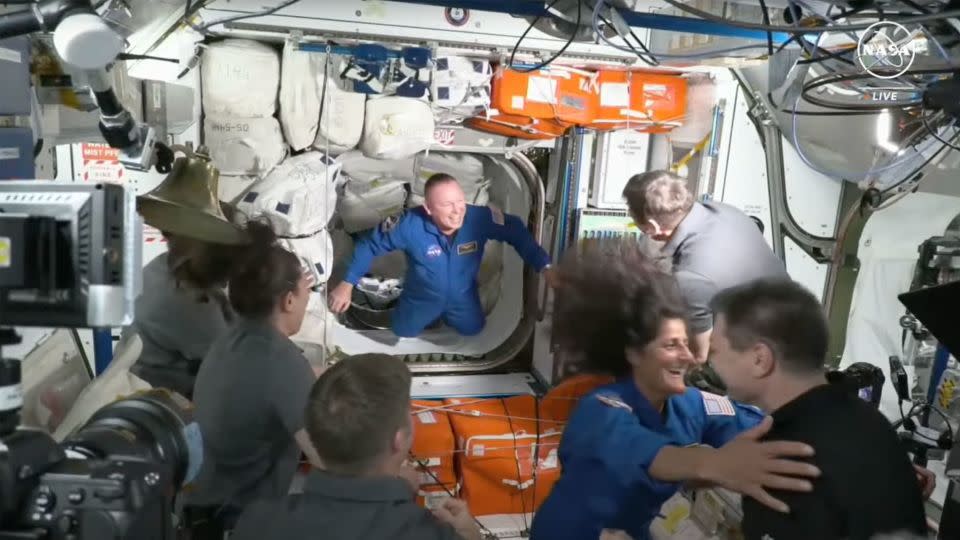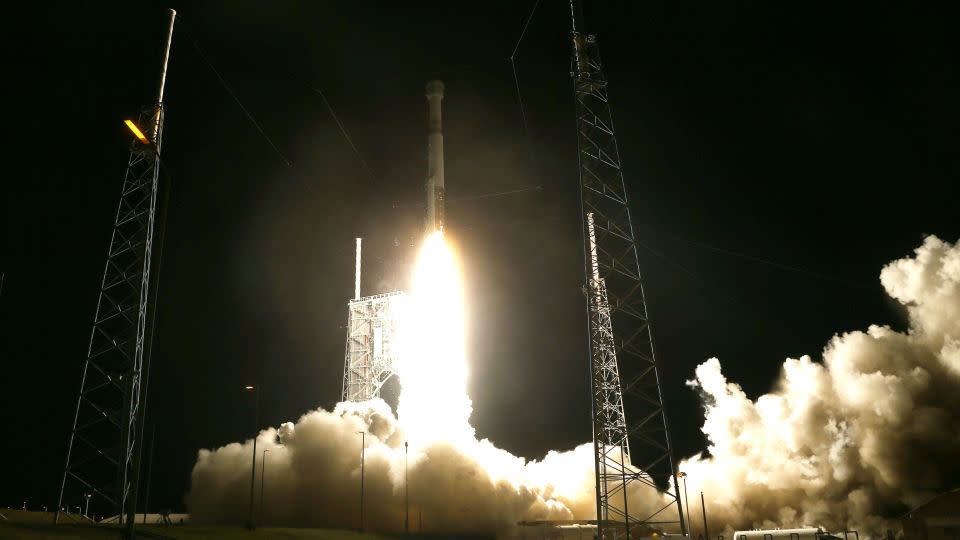[ad_1]
Subscribe to CNN's Wonder Theory newsletter. Explore the universe with news about amazing discoveries, scientific advances, and more..
A SpaceX Crew Dragon capsule will bring home two NASA astronauts who have been aboard the International Space Station for nearly 80 days due to problems with the Boeing Starliner spacecraft — marking a stunning turn of events for the beleaguered space giant.
The news comes after the space agency held a formal review on Saturday to determine whether Boeing's Starliner would be deemed safe enough to return home with its crew — or whether SpaceX's Crew Dragon spacecraft would have to step in to save the day.
The Starliner spacecraft, which carried astronauts Sunny Williams and Butch Wilmore to the space station in early June, suffered setbacks from a helium leak and thrusters that suddenly stopped working during the initial phase of its first crewed test flight. Engineers spent weeks trying to better understand the problems, and Boeing decided to restart the spacecraft. He said On August 2, the agency announced that its “confidence remains high” in the spacecraft's ability to survive. will be able To bring Williams and Wilmore back to Earth.


However, NASA revealed during a press conference on August 7 that discussions within the space agency about the safety of the Starliner capsule have evolved — prompting the federal agency to think more seriously about sending astronauts home on a spacecraft. SpaceX Crew Dragonwhich has sent about a dozen manned missions into space since 2020.
NASA Administrator Bill Nelson said Saturday that NASA took into account its vast experience in spaceflight — both successful and unsuccessful — when making the decision. According to agency officials, a poll of NASA representatives from various agency departments, research, oversight and development centers was unanimous.
“We’ve made mistakes in the past: We lost two space shuttles because we didn’t have a culture that allowed information to come out,” Nelson said. “Spaceflight is risky, even in its safest and even its most routine. Test flights, by their very nature, are neither safe nor routine.”
SpaceX is already scheduled to fly a routine mission to the International Space Station, carrying four astronauts as part of standard crew rotations aboard the orbiting laboratory. But the mission, called Crew-9, will now be reconfigured to carry two astronauts instead of four.
The change will leave two seats open for Williams and Wilmore to fill on the Crew-9 spacecraft homeward. The two astronauts will also join the Crew-9 crew, becoming part of the official mission to the International Space Station. With this change, Williams and Wilmore will remain on-site for an additional six months — the duration of a routine mission to the space station.
Reassigning the duo to Crew-9 will push their return to February 2025 at the earliest.
However, the Starliner will return home empty in early September, according to NASA. He said Saturday.
If the uncrewed return flight goes well, NASA will face a crucial decision: whether to grant Starliner official certification for human spaceflight — a step that would prepare the craft for routine trips to orbit — despite the fact that it did not complete its mission as intended.
Boeing representatives did not attend Saturday's press conference.
In a statement Saturday, Boeing said it “continues to focus, first and foremost, on the safety of the crew and spacecraft. We are executing the mission as NASA has specified, and preparing the spacecraft for a safe and successful return without a crew.”
“There is a little disagreement (between NASA and Boeing) regarding the level of risk,” Steve Stich, NASA's commercial crew program manager, said Saturday.
“It just depends on how you assess the risk,” Stitch said. “We did it a little differently with our crew than Boeing did.”
Nelson later added that he was “100 percent” certain Boeing would address the issues and get Starliner ready for another crewed mission sometime in the future.
SpaceX COO Gwynne Shotwell also responded to the news, saying: mail On X, the social media platform formerly known as Twitter.
SpaceX is ready to support @NASA “But we can do it,” Shotwell said.
Flawed motives
Five of the Starliner's 28 reactive thrust engines failed during the first phase of Boeing's test mission. All but one of the engines were eventually repaired.
While Williams and Wilmore had expected to spend only eight days in space, their stay aboard the orbiting laboratory was actually extended by nearly two months as engineers on the ground worked to better understand the thruster problems.
Officials said they were able to recreate how the thrusters deteriorated in space during flight through ground tests. Boeing said the likely root cause was heat buildup inside the thrusters that could cause the seals to bulge, restricting fuel flow.
Separately, the helium leak problems may be the result of seals that have deteriorated due to exposure to fuel vapor, according to comments by Mark Nappi, Boeing's commercial crew program manager, on July 25.
However, NASA initially had difficulty reaching a consensus on how these issues would affect astronauts' return from space — and how much risk these problems might pose.
Stitch said Saturday that uncertainty surrounding the level of risk is why the agency turned to SpaceX and its Crew Dragon spacecraft to step in.
“The bottom line with bringing Starliner back is that there was too much uncertainty in predicting the thrusters,” he said. “It was too risky with the crew, so we decided to go the unmanned route.”
Starliner's Rocky Path
NASA has repeatedly said that SpaceX's ability to interfere highlights how the space agency deliberately designed its commercial crew program — under which both Starliner and Crew Dragon were developed — to allow each spacecraft to serve as a backup for the other.
“We’re in a bit of a new situation here and we have multiple options,” Ken Bowersox, associate administrator for NASA’s Space Operations Directorate, said on Aug. 7. “This is something we’re going to have to deal with in the future — we may find ourselves in a situation where we need to bring back a SpaceX Dragon crew or a Soyuz crew on a Starliner.
“That's why we want multiple vehicles — so we have that option,” Bowersox added.
However, the federal agency funded SpaceX’s Crew Dragon spacecraft and Boeing’s Starliner at the same time in 2014. Crew Dragon has already been in service for four years, while the Starliner program is hundreds of millions of dollars over budget and years behind schedule.
Boeing's development process was also riddled with errors.
For example, the first Starliner test mission—launched in 2019 without a crew—failed in orbit, leaving the flight significantly shorter than expected. The spacecraft ultimately did not dock with the International Space Station as intended, a result that turned out to be a symptom of a myriad of software problems, including a coding error that set the internal clock back by 11 hours.


One second Drone test flight in May 2022 Additional software issues were discovered, and mission teams addressed problems with some of the vehicle's thrusters. However, the root cause of the engine problem that plagued this crewed mission two years ago was ignored.
Starliner’s certification after its return to Earth is likely to be a contentious issue, the most dangerous part of the mission. The autonomous vehicle will have to use its engines to steer itself precisely as it plunges back into Earth’s thick atmosphere. The pressure and friction are expected to heat the exterior of the craft to about 3,000 degrees Fahrenheit (1,650 degrees Celsius).
The Starliner's parachutes should then deploy without a hitch and slow the spacecraft before the airbags deploy to expand and soften the landing.
If the Starliner capsule is eventually certified, it could join SpaceX’s Crew Dragon spacecraft in making routine trips to the space station to replace personnel. Currently, such trips occur about every six months.
Cost weight
But if the spacecraft is denied certification, it would be another blow to Boeing’s already badly damaged reputation. Failure could cost the company millions of dollars more — on top of the roughly $1.5 billion it has already recorded in losses on the Starliner program.
“We all really wanted to complete the (Boeing Starliner) test flight with crew, and I think we’re unanimously disappointed that we weren’t able to do that,” Bowersox said Saturday. “But you don’t want that disappointment to negatively impact your decision.”
Boeing's cost overruns have sparked repeated rumors that the company may not be able to complete the Starliner program.
Nelson said Saturday that he recently spoke with Boeing's new CEO, Kelly Ortberg, about the Starliner situation.
“I told him how well Boeing worked with our team to come to this decision,” Nelson said. “He expressed his intention to continue working on the issues once Starliner is safely back and we have our redundancy and crew on the space station.”
But it's not yet clear who will bear the costs of additional testing and development that may be necessary to complete Starliner's development.
Nelson stressed Saturday that its deal with Boeing is a “fixed-price contract” — meaning it is designed to be a lump sum and payments do not grow with delays as they do with alternative contracts, such as “cost-plus.”
However, Nelson added that discussions about how much Boeing would be willing to pay for additional testing were not part of his conversation with the CEO.
“I don't have an answer to that question, and I don't think we will ever get an answer,” Nelson said.
For more CNN news and newsletters, create an account at CNN.com
[ad_2]
Source